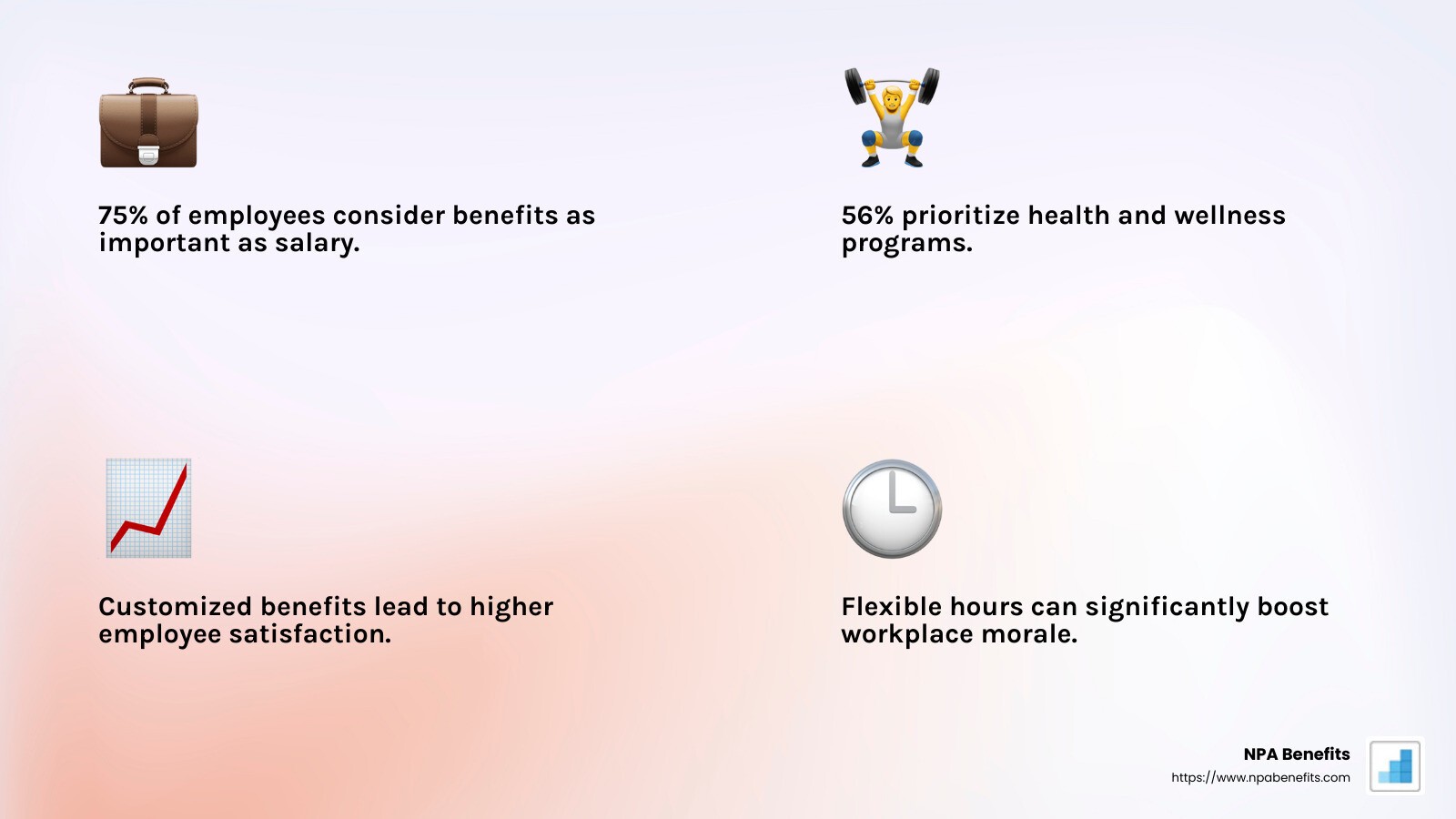Employee benefits are crucial components of a job that go beyond just a paycheck. They significantly impact employee satisfaction and retention, shaping how workers view their roles and their employer. Key benefits often include:
- Health Benefits: Coverage for medical, dental, and vision care.
- Paid Time Off (PTO): Including vacations, personal days, and sick leaves.
- Retirement Plans: Such as 401(k)s and pensions.
- Flexible Work Options: Remote work and adaptable schedules.
Providing the right mix of benefits not only aligns with company values but also fosters a culture where employees feel valued and secure in their positions.
I’m Les Perlson, an experienced partner in the insurance industry with years of expertise in designing employee benefits packages. My focus is on delivering solutions that not only meet the needs of employees but also support the financial goals of businesses.

Find more about employee benefits:
– employee retention program
– incentive plans for employees
– fringe benefits meaning
What Are Employee Benefits?
Employee benefits are more than just add-ons to a salary. They are a vital part of the compensation package that employers offer to attract and retain talent. Think of them as the extras that make a job offer more appealing.
Definition and Indirect Compensation
In simple terms, employee benefits are any perks or compensation provided by an employer beyond a worker’s basic salary. This might include health insurance, retirement plans, or paid time off. These benefits are considered indirect compensation because they provide value without directly increasing your paycheck. In fact, 81% of employees say a benefits package is crucial when deciding whether to accept a job offer.
Mandatory vs. Voluntary Benefits
Some benefits are mandatory, meaning employers must provide them by law. For instance, businesses with 50 or more full-time employees must offer health insurance that meets certain standards. Employers also need to pay into Social Security and Medicare, provide time off for military service, and comply with the Family and Medical Leave Act (FMLA).

On the other hand, voluntary benefits are those that employers offer by choice. These might include dental and vision insurance, life insurance, or retirement savings plans like 401(k)s. Even though they aren’t required, these perks can significantly improve a job offer. A recent survey found that 64% of employees frequently use their paid time off benefits, highlighting their importance in the workplace.
Why Offer Employee Benefits?
Offering a well-rounded benefits package can make your company stand out. It helps in recruiting top talent and keeping current employees happy. When workers feel valued and supported, they are more likely to stay with a company long-term. This is why many employers are investing in unique benefits that cater to the needs and preferences of their workforce.
Employee benefits are not just about meeting legal requirements. They are about creating a supportive work environment where employees feel valued and secure. This not only boosts morale but also contributes to the overall success of the organization.
Types of Employee Benefits
When it comes to employee benefits, there are several key types that companies often offer to make their job offers more attractive. Here’s a breakdown of the most common ones:
Health Insurance
Health insurance is often the cornerstone of an employee benefits package. It helps cover medical expenses and can include plans like HMOs, PPOs, and HDHPs. According to the Department of Labor, employers who provide health insurance are not only fulfilling a legal requirement but also offering a critical safety net for their employees. This benefit ensures that workers can access essential medical services without worrying about financial burdens.
Retirement Plans
Retirement plans are another vital component. These plans, such as 401(k)s, allow employees to save for their future. Often, employees can contribute a portion of their salary, which employers may match to some extent. This matching is like free money that boosts an employee’s retirement savings. According to experts, contributing as much as possible to a 401(k) plan is a smart move, especially if there’s an employer match involved.
Paid Leave
Paid leave is crucial for maintaining a healthy work-life balance. This includes vacation days, sick leave, and personal days. Paid time off (PTO) allows employees to rest and recharge without losing pay. It’s a benefit that 64% of employees frequently use, highlighting its importance in today’s work culture.
Fringe Benefits
Fringe benefits are perks that go beyond the basics. They can include company cars, gym memberships, or discounts on services. While these benefits are generally included in an employee’s gross income, they offer added value that can make a job more appealing. For example, some companies provide free or discounted commercial flights or tickets to entertainment events, which can significantly improve an employee’s lifestyle.
Wellness Programs
Wellness programs are becoming increasingly popular as companies recognize the value of a healthy workforce. These programs might offer gym memberships, biometric testing, or activity rewards. Investing in employee wellness not only improves individual health but also boosts overall productivity and engagement. In today’s post-pandemic world, wellness programs are a win-win for both employers and employees.
Incorporating these benefits into your company’s offerings can make a significant difference in attracting and retaining top talent. By understanding the different types of employee benefits and their impact, companies can create a more supportive and productive work environment.
Designing a Competitive Benefits Package
Creating a competitive benefits package is a crucial strategy for attracting and retaining top talent. It’s not just about offering the basics; it’s about crafting a package that speaks to the needs and desires of your workforce. Here’s how you can do it:
Recruitment
In today’s job market, the right benefits package can be a game-changer. When potential employees evaluate job offers, they often look beyond the salary. They want to know what else is on the table. Offering standout benefits can make your company more appealing, especially to younger workers who prioritize flexibility and wellness.
Imagine you’re a tech company trying to attract fresh talent. Offering perks like remote work options, gym memberships, and wellness programs could be the deciding factor for a candidate choosing between you and a competitor. These perks show that you care about your employees’ well-being and work-life balance.
Retention
Keeping your best employees is just as important as finding them. A well-thought-out benefits package can improve employee satisfaction and loyalty. When employees feel valued, they’re less likely to look for opportunities elsewhere.
Consider the story of a mid-sized company that introduced a student loan repayment program. This benefit was specifically designed to help millennial employees, who often carry significant student debt. The result? Increased employee retention and a boost in workplace morale. Employees felt appreciated and supported, leading to a more engaged workforce.
Workplace Morale
A competitive benefits package can also lift workplace morale. When employees know their employer is investing in their well-being, it fosters a positive and motivated work environment. Benefits like extended parental leave, mental health support, and flexible hours can make employees feel valued and reduce burnout.
According to a survey, many employees rate benefits as highly as salary when considering job satisfaction. This underscores the importance of a thoughtful benefits package in maintaining a happy and productive workforce.
Customization
One size doesn’t fit all when it comes to employee benefits. Customization allows employees to choose benefits that best suit their personal and family needs. For example, offering a menu of options like health savings accounts (HSAs), flexible spending accounts (FSAs), and different insurance plans lets employees tailor their benefits to their unique situations.
Employers who listen to their employees’ needs and adapt their benefits packages accordingly often see higher levels of satisfaction and engagement. Regularly seeking feedback and analyzing benefits utilization data can help you refine your offerings, ensuring they remain relevant and valuable.
Designing a competitive benefits package is about more than just checking boxes. It’s about understanding your workforce and offering benefits that improve their lives, both professionally and personally. This approach not only attracts new talent but also keeps your current team engaged and committed.

Next, we’ll explore how to manage these benefits effectively to maximize their impact on your organization.
Managing Employee Benefits Effectively
Managing employee benefits is like juggling many balls at once. It requires careful planning, compliance with laws, cost management, and listening to your employees. Let’s break it down.
Benefits Administration
Effective administration is the backbone of any benefits package. It involves organizing, managing, and delivering benefits to employees without any hiccups. Using benefits administration software can make this process smoother. Tools like PeopleKeep can help automate tasks, reduce errors, and save time.
Imagine trying to manually track health insurance, retirement plans, and flexible spending accounts for hundreds of employees. It would be a nightmare! Automation is key to keeping everything running smoothly.
Compliance
Staying compliant with laws and regulations is crucial. Non-compliance can lead to hefty fines and legal issues. For example, the Family and Medical Leave Act (FMLA) requires certain employers to provide unpaid, job-protected leave for specific family and medical reasons.
Keeping up with changing laws can be challenging, but it’s essential. Regular training for HR staff and audits of your benefits administration process can help ensure you’re on the right side of the law.
Cost Management
Managing costs is a balancing act. You want to offer attractive benefits without breaking the bank. One way to do this is by analyzing benefits utilization data. This can show you which benefits are most valued by employees and which ones might be cut or adjusted.
Consider the case of a company that found its employees valued health savings accounts (HSAs) more than traditional insurance plans. By shifting resources, they managed to offer a more popular benefit while saving money.
Employee Feedback
Listening to your employees is vital. Regular surveys and feedback sessions can give you insights into what benefits your employees truly value. This feedback can guide you in tweaking your benefits package to better meet their needs.
For instance, if employees express a desire for more mental health support, you might consider adding a wellness program or access to counseling services. This not only shows that you care but also helps in retaining talent.
Managing employee benefits isn’t just about maintaining the status quo. It’s about being proactive, staying compliant, and constantly seeking ways to improve. By doing so, you can create a benefits package that not only attracts top talent but also keeps your current employees happy and engaged.
Next, we’ll dive into some common questions about employee benefits and explore what employees really value.
Frequently Asked Questions about Employee Benefits
What are the most valued employee benefits?
When it comes to employee benefits, some perks consistently top the list of what employees value most.
Health Insurance: This is often the crown jewel of any benefits package. It includes medical, dental, and vision coverage. In fact, health insurance is so important that many employees rank it above a pay raise. It’s not just about covering costs when you’re sick; it’s about peace of mind. Source
Paid Time Off (PTO): Everyone needs a break. Whether it’s for a vacation, a personal day, or when you’re feeling under the weather, paid time off is crucial. Flexible PTO policies are becoming increasingly popular, allowing employees to recharge and maintain a healthy work-life balance.
Retirement Benefits: Planning for the future is essential. Retirement benefits like 401(k) plans or pensions help employees secure their financial future. Employers often match a percentage of contributions, making these plans even more attractive.
How do employee benefits impact job satisfaction?
Employee benefits play a massive role in job satisfaction. They’re not just extras; they’re crucial for attracting and keeping top talent.
Recruitment and Retention: A strong benefits package is like a magnet for new hires. It’s also a glue that keeps existing employees from leaving. According to a survey, more than 90% of employees say their job satisfaction is tied to their benefits. Source
Workplace Morale: Offering comprehensive benefits shows employees that you care about their well-being. This boosts morale and creates a positive work environment. When employees feel valued, they’re more productive and engaged.
What are fringe benefits?
Fringe benefits are the extras that go beyond the basic salary. They’re perks that sweeten the deal and make a job more attractive.
Definition and Examples: A fringe benefit can be anything from a company car to free ice cream. Common examples include gym memberships, commuter benefits, and employee discounts. Some companies get creative with their perks, like offering pet-friendly offices or free gourmet meals.
Tax Implications: Not all fringe benefits are tax-free. Some, like health insurance, are usually exempt from taxes. Others, like a company car, might be taxable if used for personal reasons. The IRS has specific rules on what is and isn’t taxable. Employers need to know these rules to avoid tax issues. Source
Understanding these FAQs about employee benefits can help you appreciate the value of a well-rounded benefits package. Next, we’ll explore how to design a competitive benefits package that meets both employer and employee needs.
Conclusion
At NPA Benefits, we understand the importance of offering flexible health insurance options that are both cost-effective and custom to meet the needs of today’s workforce. Our mission is to provide solutions that not only fit your budget but also improve employee satisfaction and retention.
Why Choose NPA Benefits?
We specialize in self-funded health insurance plans that give businesses the control they need over their health benefits. This means predictable costs and the potential for refunds on unclaimed premiums, which can significantly ease financial planning.
Flexible and Customizable Options
Our plans are designed to adapt. Whether you’re a small business or a large corporation, we offer customizable health insurance options that can grow with your company. This flexibility ensures that your employees get the coverage they need without the burden of unnecessary costs.
Cost-Saving Strategies
Partnering with us means embracing strategies that maximize value. Our level-funded health plans combine the predictability of fixed monthly payments with the flexibility to adjust as your needs change. This approach not only helps manage budgets but also provides comprehensive coverage that meets the high expectations of today’s employees.
In conclusion, choosing NPA Benefits means investing in a healthier, more sustainable future for your organization. Our expertise and innovative approaches ensure that your benefits package not only meets current standards but also anticipates future trends in healthcare. Find more about our flexible, cost-saving health insurance options and let us help you build a benefits package that keeps your employees happy and your business thriving.






